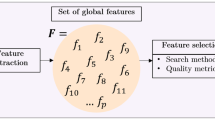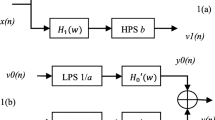Abstract
Multimedia database retrieval is rapidly growing and its popularity in online retrieval systems is consequently increasing. Large datasets are major challenges for searching, retrieving, and organizing the music content. Therefore, a robust automatic music-genre classification method is needed for organizing this music data into different classes according to specific viable information. Two fundamental components are to be considered for genre classification: audio feature extraction and classifier design. In this paper, we propose diverse audio features to precisely characterize the music content. The feature sets belong to four groups: dynamic, rhythmic, spectral, and harmonic. From the features, five statistical parameters are considered as representatives, including the fourth-order central moments of each feature as well as covariance components. Ultimately, insignificant representative parameters are controlled by minimum redundancy and maximum relevance. This algorithm calculates the score level of all feature attributes and orders them. Only high-score audio features are considered for genre classification. Moreover, we can recognize those audio features and distinguish which of the different statistical parameters derived from them are important for genre classification. Among them, mel frequency cepstral coefficient statistical parameters, such as covariance components and variance, are more frequently selected than the feature attributes of other groups. This approach does not transform the original features as do principal component analysis and linear discriminant analysis. In addition, other feature reduction methodologies, such as locality-preserving projection and non-negative matrix factorization are considered. The performance of the proposed system is measured based on the reduced features from the feature pool using different feature reduction techniques. The results indicate that the overall classification is competitive with existing state-of-the-art frame-based methodologies.

Similar content being viewed by others
References
Baniya BK, Ghimire D, Lee J (2013) Evaluation of different audio features for musical genre classification. In Proc. IEEE workshop on Signal Processing Systems, Taipei, Taiwan
Baniya BK, Ghimire D, Lee J (2014) A novel approach of automatic music genre classification based on timbral texture and rhythmic content features. Int. conference on Advance Communications Technology (ICACT), pp.96–102
Belkin M, Niyogi P (2002) “Laplacian Eigenmaps and Spectral Techniques for Embedding and Clustering”, Advances in Neural Information Processing Systems 14. Vancouver, British Columbia
Benetos E, Kotropoulos C (2008) A tensor-based approach for automatic music genre classification. Proceedings of the European Signal Processing Conference, Lausanne
Bergstra J, Casagrande N, Erhan D, Eck D, Kegl B (2006) Aggregate features and AdaBoost for music classification”. Mach Learn 65(2–3):473–484
Casey M, Veltkamp RC, Goto M, Leman M, Rhodes C, Slaney M (2008) Content-based music information retrieval: current directions and future challenges. Proc IEEE 96(4):668–696
Cortes C, Vapnik V (1995) Support vector networks. J Mach Learn
Dowling WJ, Harwood DL (1986) Music cognition. Academic
Groeneveld RA, Meeden G (1984) Measuring Skewness and Kurtosis. J R Stat Soc Ser D (Stat) 33:391–399
He X, Niyogi P (2003) Locality Preserving Projections. Proceedings of the 17thAnnual Conference on Neural Information Processing Systems. The MIT Press, Cambridge, pp 153–160
Lartillot O, Toiviainen P (2007) MIR in Matlab (II): A toolbox for musical feature extraction from audio. In Proc. Int. Conf. Music Inf. Retrieval, pp. 127–130 [Online]. Available: http://users.jyu.fi/lartillo/mirtoolbox/
Li Z, Liu J, Yang Y, Zhou X, Lu H. Clustering-guided sparse structural learning for unsupervised feature selection. IEEE Trans. Knowl. Data Eng. [Online]. Available: http://www.computer.org/csdl/trans/tk/preprint/06509368-abs.html
Li T, Ogihara M, Li Q (2003) A comparative study on content-based music genre classification. Proceedings of the 26th Annual International ACM SIGIR Conference on Research and Development in Information Retrieval, pp. 282–289, Toronto
Li Z, Yang Y, Liu J, Zhou X, Lu H (2012) Unsupervised feature selection using nonnegative spectral analysis. In: AAAI
Lidy T, Rauber A, Pertusa A, Inesta J (2007) Combining audio and symbolic descriptors for music classification from audio. Music Information Retrieval Information Exchange (MIREX)
Lim S-C, Lee J-S, Jang S-J, Lee S-P, Kim MY (2012) Music-genre classification system based on spectro-temporal features and feature selection. IEEE Trans Consum Electron 58–4:1262–1268
Marasys, Data sets http://marsysas.info/download/data
Peng H, Long F (2004) An efficient max-dependency algorithm for gene selection. In 36th Symp. Interface: Computational Biology and Bioinformatics
Peng H, Long F, Ding C (2005) Feature selection based on mutual information: Criteria of max-dependency, max-relevance and min-redundancy. IEEE Trans Pattern Anal Mach Intell 27(8):1226–1238
S Roweis, LK Saul (2000) Nonlinear dimensionality reduction by locally linear embedding. Science, 290
Scheirer E, Slaney M (1997) Construction and evaluation of a robust multi-feature speech/music discriminator, in Proc. Int. Conf. Acoustics, Speech, Signal Processing, Munich
Seo SS, Lee S (2011) Higher-order moments for musical genre classification. Signal Process 91(8):2154–2157
Shen J, Pang H, Wang M, Yan S(2012) Modeling concept dynamics for large scale music search. In Proc ACM SIGIR, pp. 455–464
Shen J, Meng W, Yan S, Pang H, Hua X (2010) Effective music tagging through advanced statistical modeling. In Proc. of ACMSIGIR
L. Smith (2002) A tutorial on principal components analysis, www.cs.otago.ac.nz/cosc453/student_tutorials/principal_components.pdf
Tzanetakis G, Cook P (2002) Musical genre classification of audio signals. IEEE Trans Speech Audio Process 10(3):293–302
Tzanetakis G, Essl G, Cook P (2001)Automatic musical genre classification of audio signals, in Proc. Int. Conf. Music Information Retrieval, Bloomington, pp. 205–210
Welling M (2000) Fisher linear discriminant analysis. Technical report, University of Toronto, Kings College Road, Toronto, M5S 3G5, Canada
Wold E, Blum T, Keislar D, Wheaten J (1996) Content based classification, search, and retrieval of audio. IEEE Trans Multimedia 3(3):27–36
Xu C, Maddage NC, Shao X (2005) Automatic music classification and summarization. IEEE Trans Speech and Audio Process 6(5):441–450
Acknowledgments
This paper was supported by research funds of Chonbuk National University in 2013 and also partially supported by the National Research Foundation of Korea grant funded by the Korean government (2011-0022152).
Author information
Authors and Affiliations
Corresponding author
Rights and permissions
About this article
Cite this article
Baniya, B.K., Lee, J. Importance of audio feature reduction in automatic music genre classification. Multimed Tools Appl 75, 3013–3026 (2016). https://doi.org/10.1007/s11042-014-2418-z
Received:
Revised:
Accepted:
Published:
Issue Date:
DOI: https://doi.org/10.1007/s11042-014-2418-z




